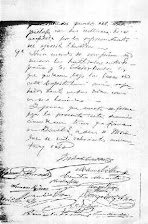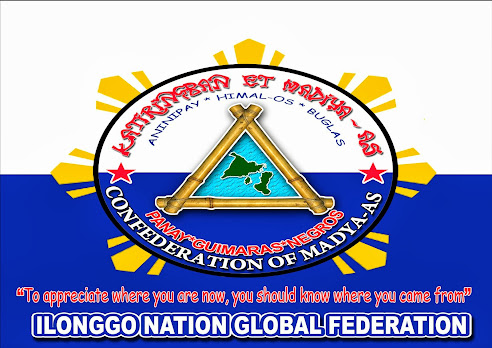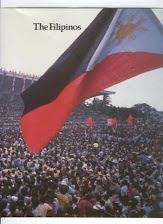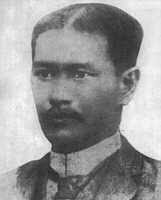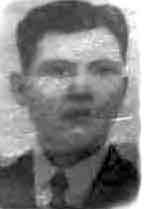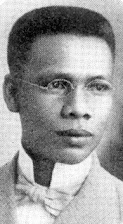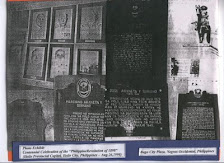To all concerned:
Greetings!
Just recently my internet access has become relatively normal, after about nine months under constant "problematic" condition.
Therefore, "Ang Pungsod Ilonggo" --the Ilonggo Nation Movement's Newsletter shall now proceed with it's internet issue and shall initiate in due time the hard copy version.
Meanwhile, here is a belated article on my trip back "home" sometime ago.
We hope afore-mentioned publications shall continue regularly.
Ang inyo alagad sa guihapon,
dinggol araneta divinagracia~~~
(Founder: The Ilonggo Nation Movement-Dec. 25, 2005)
~~~~~~~~~~~~~~~~~~~~~~~~~~~~~~~~~~~~~~~~~~~~~~~~~~~~~~~~~~~
THE LONG "ILONGGO" JOURNEY
On February 25, 2008 --after about a decade in absentia, my flight safely touched-down in Cabatuan, Iloilo and I was impressed with the new Iloilo International class airport. An ilonggo dream comes true!
I - Farewell to the Matriarchs
At noontime, I arrived in Molo "Santa Ana " Church just when the final memorial rites were about to begin. My sisters and "twice-over" first cousins obliged me to deliver the eulogy during the Requiem Mass, which I did impromptu.
Thereafter, the joint interment followed in our modest family mausoleum at the Molo Catholic Cemetary in Iloilo City, Philippines.
And so, our dearly beloved matriarchs were laid to their eternal rest.
*Adela Locsin Araneta de Divinagracia (August 4, 1914 -February 23, 2008)
*Consuelo Parcon Divinagracia de Araneta (May 18,1919-February 20,2008)
On behalf of our family, I sincerely express our gratitude to all those who have shared their sentiments with us --when Mama Adela and Mama Connie joined our Papa Joe and Papa Turing in the kingdom of their Creator, where there is no more death but only eternal joy.
Salamat gid! Sa tanan nga nagbuylog sa amon kalisud sadtong mga panahon...
From the Children:
*Ma. Lina (Marlyn)....................*Concha & Rey
*Carmeling & Junior...................*Agnes & Lando
*Dinggol & Lilia......................*Tony & Maridel
*Susan & Erning.......................*Inday Ling & Irwin
*Boy & Marilu......................*Inday Ting & Jessie
*Marcia & Boy.........................*Inday Bing & David
*Bino & Soling........................*and the Grandchildren
~~~~~~~~~~~~~~~~~~~~~~~~~~~oo0oo~~~~~~~~~~~~~~~~~~~~~~~
II - Padayon ang Hublag Ilonggo
*The Ilonggo Nation Movement (INM)*
Confucius once said: "A long journey begins with the first step".
It has been said; that something as small as a flutter of a butterfly's wing, can ultimately cause a typhoon halfway around the world.
The long overdue vacation back home, afforded me the chance to personally "eyeball" for the first time with several enthusiastic INM members and sympathizers in Panay and Negros.
Likewise, with four others from abroad who just came over, curious to meet me personally --to discuss on how to concretize INM's course of action in furtherance with the Movement's advocacy presently via cyberspace.
Important issues were discussed and thoroughly deliberated and relevant matters were seriously considered during the "Low Profile" conference held somewhere in Bacolod City.
INM members present, who belong to local media, eager for a "Scoop" --were advised to refrain from covering the historic event since the public at-large; due to limited internet access within WV area, might not fully comprehend INM's agenda for now. And our noble objectives could be misconstrued, even jeopardized.
However, in due time after the printed (hard) copy of "Ang Pungsod Ilonggo" INM Newsletter begins in circulation "Gratis et Amore", all responsible tri-media practitioners shall be properly entertained.
Thereafter, ang aton mga kasimanwa sa Kabisay-an Nakatungdan, shall be able to learn the "true" history of the Ilonggo Nation; be guided accordingly to actively participate in the preservation of our rich cultural heritage and abundant natural resources; and be emboldened, to fight fearlessly against the "Ogres" of society responsible for the maladies that now confronts our people.
Padayon Kita! Wala Punaw!
Today: the Ilonggo Nation...Tomorrow: A Federal Filipino Nation!
~~~~~~~~~~~~~~~~~~~~~~~~~~~~oo0oo~~~~~~~~~~~~~~~~~~~~~~
III - Highlights of my Trip
(Aklan)
After the usual post memorial activities, I proceeded to Aklan upon invitation of primo Greg Montinola Sanson for his natal day celebration in their family owned beach hotel-resort. A brief stop-over in Kalibo, enabled me to clarify some issues with several INM sympathizers waiting at the bus terminal and who later drove me to Malay's Caticlan Pier for Boracay.
A nostalgic reunion with other guests in the island resort --of long lost kins and friends; also meeting new acquaintances was a memorable experience.
Surprisingly, I met an avid "Ang Pungsod Ilonggo" eNewsletter reader. He was the jolly Manila Lawyer "Pompoy", scion of the illustrious Dinglasan Clan of Capiz, who "stole the show" with his songs and dancing style. His contemporaries were the TV dancing "Gurus" of the yesteryears; Chito Feliciano and Archie Lacson.
Thanks! Primo Greg and Prima Marilou Tirol-Sanson for your very generous hospitality. And kudos to the staff for job well done.
(Iloilo)
I visited the towns of Pavia, Sta. Barbara, New Lucena, Dumangas and Cabatuan to meet INM members and sympathizers.
Sta. Barbara was of course, the site of the historic "Cry of Freedom" by Visayan Revolucionarios on November 17, 1898.
While Cabatuan, was the last seat of the embattled Federal Visayan Government that still continued to function while fighting U.S. invasion forces against all odds during the turn of the last century. The Ilonggo leaders ignored the decree abolishing the Federal Republic of the Visayas issued by Gen. Emilio Aguinaldo on April 27, 1899 since they were not under his jurisdiction..
In Iloilo City, informal meetings were held with several NGO's and student groups; likewise, with several active and retired police and military officers.
More notably, with environmentalist Melvin Purzuelo --Head of Western Visayas Green Peace and Convenor of Responsible Ilonggos for Sustainable Eneregy (RISE) and Rodelen Paccial of the Western Visayas State University. Salamat! utod Melvin for the groups' laudable initiative after Typhoon Franks devastation. And to utod "Toto Rod" for that logical suggestion, it's well taken...
(Negros Occidental)
An absence in Silay City for a very long time has made personal contact with relatives mutually more touching. I was deeply elated to learn that many kins and acquaintances are INM members and/or sympathizers.
I was able to confirm from elders, thru old documents the role of the "Locsins" during the 1898 Revolution in Negros and Panay:
*That Gen. Leandro de la Rama Locsin --was Alcalde Municipal and Head "Comite de Silay" under the "Comite Revolucionario Zona Norte Negros Occidental" led by Gen. Aniceto Ledesma Lacson; whose members also included: Simon Lizares, Jose Ledesma, Nicolas Golez Coloso, Dr. Lope de la Rama and Melecio Severino-Secretary.
*That Gen. Leandro Locsin Fullon, the Revolutionary hero of Antique Province --was the son of Justo Fullon and Justa Locsin. His siblings were named Baltazara, Luisa and Jose. Gen. Fullon's daughter in Manila married Roberto Pacificador of the "Rentas Internas".
*That Dr. Vicente Armada Locsin of Janiuay, Iloilo acted as Confidential Intelligence Emissary with the Central Revolutionary Committee of Iloilo based in "Parian" now Molo.
The Committee was headed by Don Raymundo Angulo Melliza with Gen. Pablo Soriano Araneta, a Physician-Surgeon; Don Francisco Felipe Villanueva, Gen. Angel Corteza; Don Ramon Avancena and Don Francisco Soriano as members.
Later, Dr. Vicente A. Locsin married Dna Trinidad Teves and settled permanently in Dumaguete City, Negros Oriental.
During my stay in Talisay City, Joel D. Liboon related to me that his great Grandpa Alfonso Garcia Liboon, served as the first Northern Negros Supervising Public School Teacher during the early American regime. While other family members fought under "Papa Isio" Sigobeyla against U.S. forces in Murcia and over the hills of Negros.
Utod "Joel" was the Charter President of the Talisay City (Host) Lions Club in Negros Occidental. Presently, he is District Deputy of the Knights of Columbus for V-83 (Whole Visayas) and a past Grand Knight of the K of C.
Also in Talisay, I talked to "Caloy" Claparols Balcells, a great grandson of erstwhile Negros Presidente Gen. Aniceto L. Lacson regarding some historical family matters. His branch of the family who participated during our 1993 first Araneta family grand reunion in Iloilo City was quite impressive.
In Bacolod City, Hansy Alojado, a young faculty member of De La Salle University was "all smiles" when we met for the first time. He is an ardent ilonggo martial arts practitioner. Yes! "Utod Hansy" --- "Kali" preceded Arnis de Mano.
To my "Big Time" former classmate Renier Geroche and family --Salamat gid! for your very generous hospitality. The food and spirits in that more affluent Japanese Restaurant was excellent.
The bemoustached Renier, an amateur golf enthusiast is presently the District Governor of Rotary Club International for Visayas and Mindanao in the Philippines.
I also met Jimmy Araneta of Bago City --one of the five "Jimmy A's" he jokingly said. He is the grandson of Col. Jaime Sarmiento Araneta of the Negros Revolutionary Forces, the son of Gen. Juan Araneta y Torres. The imposing mounted statue of "Tan Juan" in Bago City Plaza is a revered historical landmark.
Salamat! Jimmy for extending best wishes from "Primo Saming". Dr. Samson Araneta Gonzaga is the President of the Gen. Juan Araneta Family Association, Inc. based in Bago City, Negros Occidental.
Likewise, for the first time I met a grandson of Dionisio "Papa Isio" Sigobeyla of Cauayan, who was kind to allow me take photo shots of the original "anting-anting" (amulet) worn by the forgotten Negros revolutionary hero and patriot.
"Papa Isio" a "Babaylan", declared himself head of the Negros Republic and continued the struggle for freedom for eight more years fighting U.S. forces after Gen. Aniceto Lacson -President of the Negros Island government surrendered to the American invaders.
(Negros Oriental)
In Guihulngan, Ben Bacalso Ricarte told me that the mother of Ilokano revolutionary leader Gen. Artemio "Vibora" Ricarte (who never pledged allegiance to the U.S.) was from Mambusao, Capiz. This I have to check.
Rey Serion of Vallehermoso, great grandson of Don Diego de la Viña informed me that "Don Diego" had three daughters, who married a Serion, a Morales and a Villegas. He also said the historical marker in his honor was put up in Dumaguete City only very recently.
Don Diego de la Viña, a Manila born Spanish-Chinese mestizo who married a wealthy Ilongga, owned large tracts of land in Negros Island including Hacienda Vallehermoso in Guihulngan. He led the revolucionarios who defeated the Spanish authorities in Dumaguete City. (As contained in "A Chronology: The Ilonggo Nation" first posted in INM website on December 25, 2005).
It should also be noted, that the Bacolod City historical marker commemorating Spain's formal surrender to the Negros cantonal government was also erected in Bacolod City only after 109 years on November 6, 2007 ---after the afore-mentioned INM article was published. The Negros Occidental Provincial Information Office under the late Gov. Joseph Maranon acknowledged INM's article contribution.
Unfortunately, however, I noticed the National Historical Institute (NHI) plaque only narrated the Spanish Forces capitulation under Col. Isidro de Castro, Negros Politicol-Military Governor; and not that the formal surrender document (Acta de Capitulacion) was authorized by the last duly constituted Spanish authority in the Philippine archipelago...Governor-General Don Diego de los Rios.
Due to previous Iloilo scheduled appointments and time constraints, my Dumaguete City trip was cancelled.
(Back to Iloilo City)
I enjoyed a sumptuous "Comida" together with Manang Eva Araneta-Serra in the "Swiss Chalet" of the Loring-Gay ancestral home fronting University of San Agustin where my "habla español" almost ran-out.
Our gracious hostess, Dña. Amparo Gay Loring de Hernandez was enthusiastic to discuss with me early family genealogy, due to proddings by her children about their maternal great grandma's (Trinidad) side of the familia. The feeling was mutual, since the subject ancestor was the sister of (Paz) my very own maternal great grandma. The third sister Candelaria, married Francisco Tejador Cacho, patriarch of the Cacho Hermanos.
Moreover, I was also eager to hear her testimonies about Iloilo historical events directly involving her close family members. Tita Amparing confirmed that the last Iloilo Spanish "Alcalde Mayor" was Jose Ma. Gay, her mother Concha's brother and not her "abuelo" Don Vicente Gay as portrayed in some articles and historical accounts.
On December 23, 1898; To avert further bloodshed --Iloilo "Alcalde-Mayor" Jose Ma. Gay y Soriano accepted Spain's banner and official sabre, symbol of authority relinquished by the last duly constituted Spanish Governor-General in "Islas Filipinas", Don Diego de los Rios for formal surrender to leaders of the approaching victorious Ilonggo revolucionarios.
The committee for the surrender was negotiated by the members of the revolutionary council, namely: Jovito Servando Yusay, Ramon Avanceña, Francisco Felipe Villanueva with Francisco Ditching Soriano and Gen. Pablo Soriano Araneta as requested by the Alcalde-Mayor being his first cousins. Also present was Don Juan de Leon, who was later appointed first Presidente-Ciudad de Iloilo of the Estado Federal de Bisayas that replaced Jose Ma. Gay.
This was the day prior to Don Diego's departure to Spain via Zamboanga together with the Negros and Cebu Politico-Military Governors; Col. Isidro de Castro and Gen. Adolfo Montero respectively.
Madamo man nga salamat! to Cecile Campos-Jarantilla for my favorite dish "Lengua Estofada" at the cozy Montelibano Restaurant in Tabucan, Mandurriao. Likewise, to Tita Emma Esteban-Campos for copies of old family documents and photos she entrusted to me.
The amiable Cecile introduced me to Fr. Calixto Enojo in his Lapaz home where we talked about history for hours. Fr. Enojo (77), a retiree both as secular priest and AFP Chaplain is well versed on ilonggo history. He is also aware of the omissions and discrepancies in our history books and commented that nobody seems to care.
Politely, I explained INM's primordial objective; to attempt rectify these historical blunders and asked for his opinion and blessing.
Before we parted ways, Fr. Calixto Enojo sincerely said in a low tone voice; "Padayona ninyo ina Toto, ma-ayo gid ina nga kausa".
~~~~~~~~~~~~~~~~~~~~~
(Night with the General -in Manila)
Michaelangelo Hubero Siscar of Bulacan, the first "Pavianhon" in Iloilo to acquire the AFP Star Rank, came to meet me for the first time with invitation for my "last supper" in the Philippines. Salamat! BGen. Michael for the invite at the huge Mall of Asia, where we ate and drink with gusto in that great Resto Bar.
Hoping next meeting, we shall have the luxury of time for a more better acquantanceship.
(Back to the U.S.A.)
After a weeks stay in Michigan, rubbing elbows with members of the Ilonggo Association of Michigan (ILAM-USA), Inc. --I proceded to the Metropolitan Washington D.C. area with one night stop-over at Philadelphia in Pennsylvania.
In Philly, I stayed with INM Co-founder Benjie Estuche where we discussed future INM activities. Salamat! Agurang Amin kang imo pagkabalaka..
In Rockville, Maryland --during a social function, I interacted with members of the Association of Ilonggos of Metropolitan Washington D.C.(AIM), Inc. --AIM, Inc. is a tax exempt organization with over a thousand members within the Nations' Capital, State of Maryland and the Commonwealth of Virginia.
I also met David, Judy and several INM members/sympathizers during the affair coming from Canada.
In Woodbridge, Virginia --Monching Jocson of Bacolod and Himamaylan, an INM Co-founder tendered a "bienvenida" party for me, attended by Virginians from Negros Occidental.
From Fallujah, Iraq --I received email best wishes with photos in full U.S. Army combat gear of New York based INM member whose maternal ggrandad Col. Macario Sarmiento was Minister of Police of the Bohol Cantonal government under the Federal Republic of the Visayas in Sta. Barbara, Iloilo during the late 1890's.
Regretably, I was saddened to learn the demise in Iloilo of cancer stricken New York based INM Co-founder Nestor Ortiz Sulpico. He was dubbed by U.S. mainstream media, as the "Honest Cab Driver of New York" and in the Philippines as "Bagong Bayani ng Pilipinas" in the year 2005. Utod Nestor returned $80-K worth of rare black pearls left by a passenger in his taxi cab.
(I Shall Return)
The rapid growth in membership, especially among the enlightened studentry; concerned professionals and with more pledging support for INM's advocacy from advantaged Ilonggo expatriates, made me contemplate going back "home" once more to personally guide the groups direction.
We believe and are confident that with the advent of modern technology; somewhere, sometime in the near future, somebody out there --destined by fate shall emerge to lead us reach the long journey that we at INM had began and thus, finally fulfill our dream: "The Rebirth of the Ilonggo Nation".
Ang inyo alagad sa guihapon...--dinggol araneta divinagracia~~~.
Greetings!
Just recently my internet access has become relatively normal, after about nine months under constant "problematic" condition.
Therefore, "Ang Pungsod Ilonggo" --the Ilonggo Nation Movement's Newsletter shall now proceed with it's internet issue and shall initiate in due time the hard copy version.
Meanwhile, here is a belated article on my trip back "home" sometime ago.
We hope afore-mentioned publications shall continue regularly.
Ang inyo alagad sa guihapon,
dinggol araneta divinagracia~~~
(Founder: The Ilonggo Nation Movement-Dec. 25, 2005)
~~~~~~~~~~~~~~~~~~~~~~~~~~~~~~~~~~~~~~~~~~~~~~~~~~~~~~~~~~~
THE LONG "ILONGGO" JOURNEY
On February 25, 2008 --after about a decade in absentia, my flight safely touched-down in Cabatuan, Iloilo and I was impressed with the new Iloilo International class airport. An ilonggo dream comes true!
I - Farewell to the Matriarchs
At noontime, I arrived in Molo "Santa Ana " Church just when the final memorial rites were about to begin. My sisters and "twice-over" first cousins obliged me to deliver the eulogy during the Requiem Mass, which I did impromptu.
Thereafter, the joint interment followed in our modest family mausoleum at the Molo Catholic Cemetary in Iloilo City, Philippines.
And so, our dearly beloved matriarchs were laid to their eternal rest.
*Adela Locsin Araneta de Divinagracia (August 4, 1914 -February 23, 2008)
*Consuelo Parcon Divinagracia de Araneta (May 18,1919-February 20,2008)
On behalf of our family, I sincerely express our gratitude to all those who have shared their sentiments with us --when Mama Adela and Mama Connie joined our Papa Joe and Papa Turing in the kingdom of their Creator, where there is no more death but only eternal joy.
Salamat gid! Sa tanan nga nagbuylog sa amon kalisud sadtong mga panahon...
From the Children:
*Ma. Lina (Marlyn)....................*Concha & Rey
*Carmeling & Junior...................*Agnes & Lando
*Dinggol & Lilia......................*Tony & Maridel
*Susan & Erning.......................*Inday Ling & Irwin
*Boy & Marilu......................*Inday Ting & Jessie
*Marcia & Boy.........................*Inday Bing & David
*Bino & Soling........................*and the Grandchildren
~~~~~~~~~~~~~~~~~~~~~~~~~~~oo0oo~~~~~~~~~~~~~~~~~~~~~~~
II - Padayon ang Hublag Ilonggo
*The Ilonggo Nation Movement (INM)*
Confucius once said: "A long journey begins with the first step".
It has been said; that something as small as a flutter of a butterfly's wing, can ultimately cause a typhoon halfway around the world.
The long overdue vacation back home, afforded me the chance to personally "eyeball" for the first time with several enthusiastic INM members and sympathizers in Panay and Negros.
Likewise, with four others from abroad who just came over, curious to meet me personally --to discuss on how to concretize INM's course of action in furtherance with the Movement's advocacy presently via cyberspace.
Important issues were discussed and thoroughly deliberated and relevant matters were seriously considered during the "Low Profile" conference held somewhere in Bacolod City.
INM members present, who belong to local media, eager for a "Scoop" --were advised to refrain from covering the historic event since the public at-large; due to limited internet access within WV area, might not fully comprehend INM's agenda for now. And our noble objectives could be misconstrued, even jeopardized.
However, in due time after the printed (hard) copy of "Ang Pungsod Ilonggo" INM Newsletter begins in circulation "Gratis et Amore", all responsible tri-media practitioners shall be properly entertained.
Thereafter, ang aton mga kasimanwa sa Kabisay-an Nakatungdan, shall be able to learn the "true" history of the Ilonggo Nation; be guided accordingly to actively participate in the preservation of our rich cultural heritage and abundant natural resources; and be emboldened, to fight fearlessly against the "Ogres" of society responsible for the maladies that now confronts our people.
Padayon Kita! Wala Punaw!
Today: the Ilonggo Nation...Tomorrow: A Federal Filipino Nation!
~~~~~~~~~~~~~~~~~~~~~~~~~~~~oo0oo~~~~~~~~~~~~~~~~~~~~~~
III - Highlights of my Trip
(Aklan)
After the usual post memorial activities, I proceeded to Aklan upon invitation of primo Greg Montinola Sanson for his natal day celebration in their family owned beach hotel-resort. A brief stop-over in Kalibo, enabled me to clarify some issues with several INM sympathizers waiting at the bus terminal and who later drove me to Malay's Caticlan Pier for Boracay.
A nostalgic reunion with other guests in the island resort --of long lost kins and friends; also meeting new acquaintances was a memorable experience.
Surprisingly, I met an avid "Ang Pungsod Ilonggo" eNewsletter reader. He was the jolly Manila Lawyer "Pompoy", scion of the illustrious Dinglasan Clan of Capiz, who "stole the show" with his songs and dancing style. His contemporaries were the TV dancing "Gurus" of the yesteryears; Chito Feliciano and Archie Lacson.
Thanks! Primo Greg and Prima Marilou Tirol-Sanson for your very generous hospitality. And kudos to the staff for job well done.
(Iloilo)
I visited the towns of Pavia, Sta. Barbara, New Lucena, Dumangas and Cabatuan to meet INM members and sympathizers.
Sta. Barbara was of course, the site of the historic "Cry of Freedom" by Visayan Revolucionarios on November 17, 1898.
While Cabatuan, was the last seat of the embattled Federal Visayan Government that still continued to function while fighting U.S. invasion forces against all odds during the turn of the last century. The Ilonggo leaders ignored the decree abolishing the Federal Republic of the Visayas issued by Gen. Emilio Aguinaldo on April 27, 1899 since they were not under his jurisdiction..
In Iloilo City, informal meetings were held with several NGO's and student groups; likewise, with several active and retired police and military officers.
More notably, with environmentalist Melvin Purzuelo --Head of Western Visayas Green Peace and Convenor of Responsible Ilonggos for Sustainable Eneregy (RISE) and Rodelen Paccial of the Western Visayas State University. Salamat! utod Melvin for the groups' laudable initiative after Typhoon Franks devastation. And to utod "Toto Rod" for that logical suggestion, it's well taken...
(Negros Occidental)
An absence in Silay City for a very long time has made personal contact with relatives mutually more touching. I was deeply elated to learn that many kins and acquaintances are INM members and/or sympathizers.
I was able to confirm from elders, thru old documents the role of the "Locsins" during the 1898 Revolution in Negros and Panay:
*That Gen. Leandro de la Rama Locsin --was Alcalde Municipal and Head "Comite de Silay" under the "Comite Revolucionario Zona Norte Negros Occidental" led by Gen. Aniceto Ledesma Lacson; whose members also included: Simon Lizares, Jose Ledesma, Nicolas Golez Coloso, Dr. Lope de la Rama and Melecio Severino-Secretary.
*That Gen. Leandro Locsin Fullon, the Revolutionary hero of Antique Province --was the son of Justo Fullon and Justa Locsin. His siblings were named Baltazara, Luisa and Jose. Gen. Fullon's daughter in Manila married Roberto Pacificador of the "Rentas Internas".
*That Dr. Vicente Armada Locsin of Janiuay, Iloilo acted as Confidential Intelligence Emissary with the Central Revolutionary Committee of Iloilo based in "Parian" now Molo.
The Committee was headed by Don Raymundo Angulo Melliza with Gen. Pablo Soriano Araneta, a Physician-Surgeon; Don Francisco Felipe Villanueva, Gen. Angel Corteza; Don Ramon Avancena and Don Francisco Soriano as members.
Later, Dr. Vicente A. Locsin married Dna Trinidad Teves and settled permanently in Dumaguete City, Negros Oriental.
During my stay in Talisay City, Joel D. Liboon related to me that his great Grandpa Alfonso Garcia Liboon, served as the first Northern Negros Supervising Public School Teacher during the early American regime. While other family members fought under "Papa Isio" Sigobeyla against U.S. forces in Murcia and over the hills of Negros.
Utod "Joel" was the Charter President of the Talisay City (Host) Lions Club in Negros Occidental. Presently, he is District Deputy of the Knights of Columbus for V-83 (Whole Visayas) and a past Grand Knight of the K of C.
Also in Talisay, I talked to "Caloy" Claparols Balcells, a great grandson of erstwhile Negros Presidente Gen. Aniceto L. Lacson regarding some historical family matters. His branch of the family who participated during our 1993 first Araneta family grand reunion in Iloilo City was quite impressive.
In Bacolod City, Hansy Alojado, a young faculty member of De La Salle University was "all smiles" when we met for the first time. He is an ardent ilonggo martial arts practitioner. Yes! "Utod Hansy" --- "Kali" preceded Arnis de Mano.
To my "Big Time" former classmate Renier Geroche and family --Salamat gid! for your very generous hospitality. The food and spirits in that more affluent Japanese Restaurant was excellent.
The bemoustached Renier, an amateur golf enthusiast is presently the District Governor of Rotary Club International for Visayas and Mindanao in the Philippines.
I also met Jimmy Araneta of Bago City --one of the five "Jimmy A's" he jokingly said. He is the grandson of Col. Jaime Sarmiento Araneta of the Negros Revolutionary Forces, the son of Gen. Juan Araneta y Torres. The imposing mounted statue of "Tan Juan" in Bago City Plaza is a revered historical landmark.
Salamat! Jimmy for extending best wishes from "Primo Saming". Dr. Samson Araneta Gonzaga is the President of the Gen. Juan Araneta Family Association, Inc. based in Bago City, Negros Occidental.
Likewise, for the first time I met a grandson of Dionisio "Papa Isio" Sigobeyla of Cauayan, who was kind to allow me take photo shots of the original "anting-anting" (amulet) worn by the forgotten Negros revolutionary hero and patriot.
"Papa Isio" a "Babaylan", declared himself head of the Negros Republic and continued the struggle for freedom for eight more years fighting U.S. forces after Gen. Aniceto Lacson -President of the Negros Island government surrendered to the American invaders.
(Negros Oriental)
In Guihulngan, Ben Bacalso Ricarte told me that the mother of Ilokano revolutionary leader Gen. Artemio "Vibora" Ricarte (who never pledged allegiance to the U.S.) was from Mambusao, Capiz. This I have to check.
Rey Serion of Vallehermoso, great grandson of Don Diego de la Viña informed me that "Don Diego" had three daughters, who married a Serion, a Morales and a Villegas. He also said the historical marker in his honor was put up in Dumaguete City only very recently.
Don Diego de la Viña, a Manila born Spanish-Chinese mestizo who married a wealthy Ilongga, owned large tracts of land in Negros Island including Hacienda Vallehermoso in Guihulngan. He led the revolucionarios who defeated the Spanish authorities in Dumaguete City. (As contained in "A Chronology: The Ilonggo Nation" first posted in INM website on December 25, 2005).
It should also be noted, that the Bacolod City historical marker commemorating Spain's formal surrender to the Negros cantonal government was also erected in Bacolod City only after 109 years on November 6, 2007 ---after the afore-mentioned INM article was published. The Negros Occidental Provincial Information Office under the late Gov. Joseph Maranon acknowledged INM's article contribution.
Unfortunately, however, I noticed the National Historical Institute (NHI) plaque only narrated the Spanish Forces capitulation under Col. Isidro de Castro, Negros Politicol-Military Governor; and not that the formal surrender document (Acta de Capitulacion) was authorized by the last duly constituted Spanish authority in the Philippine archipelago...Governor-General Don Diego de los Rios.
Due to previous Iloilo scheduled appointments and time constraints, my Dumaguete City trip was cancelled.
(Back to Iloilo City)
I enjoyed a sumptuous "Comida" together with Manang Eva Araneta-Serra in the "Swiss Chalet" of the Loring-Gay ancestral home fronting University of San Agustin where my "habla español" almost ran-out.
Our gracious hostess, Dña. Amparo Gay Loring de Hernandez was enthusiastic to discuss with me early family genealogy, due to proddings by her children about their maternal great grandma's (Trinidad) side of the familia. The feeling was mutual, since the subject ancestor was the sister of (Paz) my very own maternal great grandma. The third sister Candelaria, married Francisco Tejador Cacho, patriarch of the Cacho Hermanos.
Moreover, I was also eager to hear her testimonies about Iloilo historical events directly involving her close family members. Tita Amparing confirmed that the last Iloilo Spanish "Alcalde Mayor" was Jose Ma. Gay, her mother Concha's brother and not her "abuelo" Don Vicente Gay as portrayed in some articles and historical accounts.
On December 23, 1898; To avert further bloodshed --Iloilo "Alcalde-Mayor" Jose Ma. Gay y Soriano accepted Spain's banner and official sabre, symbol of authority relinquished by the last duly constituted Spanish Governor-General in "Islas Filipinas", Don Diego de los Rios for formal surrender to leaders of the approaching victorious Ilonggo revolucionarios.
The committee for the surrender was negotiated by the members of the revolutionary council, namely: Jovito Servando Yusay, Ramon Avanceña, Francisco Felipe Villanueva with Francisco Ditching Soriano and Gen. Pablo Soriano Araneta as requested by the Alcalde-Mayor being his first cousins. Also present was Don Juan de Leon, who was later appointed first Presidente-Ciudad de Iloilo of the Estado Federal de Bisayas that replaced Jose Ma. Gay.
This was the day prior to Don Diego's departure to Spain via Zamboanga together with the Negros and Cebu Politico-Military Governors; Col. Isidro de Castro and Gen. Adolfo Montero respectively.
Madamo man nga salamat! to Cecile Campos-Jarantilla for my favorite dish "Lengua Estofada" at the cozy Montelibano Restaurant in Tabucan, Mandurriao. Likewise, to Tita Emma Esteban-Campos for copies of old family documents and photos she entrusted to me.
The amiable Cecile introduced me to Fr. Calixto Enojo in his Lapaz home where we talked about history for hours. Fr. Enojo (77), a retiree both as secular priest and AFP Chaplain is well versed on ilonggo history. He is also aware of the omissions and discrepancies in our history books and commented that nobody seems to care.
Politely, I explained INM's primordial objective; to attempt rectify these historical blunders and asked for his opinion and blessing.
Before we parted ways, Fr. Calixto Enojo sincerely said in a low tone voice; "Padayona ninyo ina Toto, ma-ayo gid ina nga kausa".
~~~~~~~~~~~~~~~~~~~~~
(Night with the General -in Manila)
Michaelangelo Hubero Siscar of Bulacan, the first "Pavianhon" in Iloilo to acquire the AFP Star Rank, came to meet me for the first time with invitation for my "last supper" in the Philippines. Salamat! BGen. Michael for the invite at the huge Mall of Asia, where we ate and drink with gusto in that great Resto Bar.
Hoping next meeting, we shall have the luxury of time for a more better acquantanceship.
(Back to the U.S.A.)
After a weeks stay in Michigan, rubbing elbows with members of the Ilonggo Association of Michigan (ILAM-USA), Inc. --I proceded to the Metropolitan Washington D.C. area with one night stop-over at Philadelphia in Pennsylvania.
In Philly, I stayed with INM Co-founder Benjie Estuche where we discussed future INM activities. Salamat! Agurang Amin kang imo pagkabalaka..
In Rockville, Maryland --during a social function, I interacted with members of the Association of Ilonggos of Metropolitan Washington D.C.(AIM), Inc. --AIM, Inc. is a tax exempt organization with over a thousand members within the Nations' Capital, State of Maryland and the Commonwealth of Virginia.
I also met David, Judy and several INM members/sympathizers during the affair coming from Canada.
In Woodbridge, Virginia --Monching Jocson of Bacolod and Himamaylan, an INM Co-founder tendered a "bienvenida" party for me, attended by Virginians from Negros Occidental.
From Fallujah, Iraq --I received email best wishes with photos in full U.S. Army combat gear of New York based INM member whose maternal ggrandad Col. Macario Sarmiento was Minister of Police of the Bohol Cantonal government under the Federal Republic of the Visayas in Sta. Barbara, Iloilo during the late 1890's.
Regretably, I was saddened to learn the demise in Iloilo of cancer stricken New York based INM Co-founder Nestor Ortiz Sulpico. He was dubbed by U.S. mainstream media, as the "Honest Cab Driver of New York" and in the Philippines as "Bagong Bayani ng Pilipinas" in the year 2005. Utod Nestor returned $80-K worth of rare black pearls left by a passenger in his taxi cab.
(I Shall Return)
The rapid growth in membership, especially among the enlightened studentry; concerned professionals and with more pledging support for INM's advocacy from advantaged Ilonggo expatriates, made me contemplate going back "home" once more to personally guide the groups direction.
We believe and are confident that with the advent of modern technology; somewhere, sometime in the near future, somebody out there --destined by fate shall emerge to lead us reach the long journey that we at INM had began and thus, finally fulfill our dream: "The Rebirth of the Ilonggo Nation".
Ang inyo alagad sa guihapon...--dinggol araneta divinagracia~~~.
